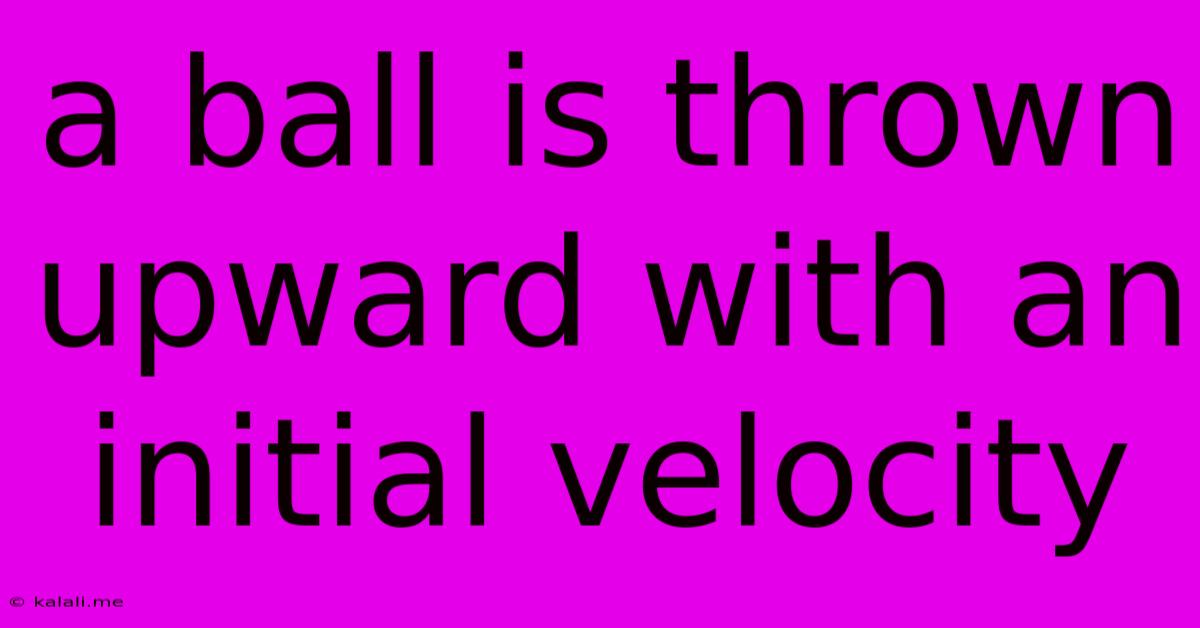A Ball Is Thrown Upward With An Initial Velocity
Kalali
Jun 14, 2025 · 3 min read

Table of Contents
Analyzing the Trajectory of a Ball Thrown Upward: A Physics Perspective
This article delves into the physics behind projectile motion, specifically analyzing the trajectory of a ball thrown upward with an initial velocity. We'll explore the key concepts, equations, and factors influencing the ball's flight path, making it suitable for students and anyone interested in understanding basic physics principles. This exploration includes calculations, graphs, and practical considerations.
Understanding Projectile Motion
When a ball is thrown upward, it exhibits projectile motion – a form of motion experienced by an object projected near the Earth's surface and subject only to gravity. Neglecting air resistance (a simplification for easier calculation), the motion can be analyzed using basic kinematic equations. The key factors are the initial velocity (speed and direction), the acceleration due to gravity, and the time elapsed.
Key Variables and Equations
- Initial Velocity (v₀): The speed at which the ball is thrown upward. This is crucial in determining the maximum height and total flight time.
- Acceleration due to gravity (g): Approximately 9.8 m/s² on Earth, acting downwards. This constant acceleration causes the ball's upward velocity to decrease until it reaches zero at its highest point, then accelerates it downwards.
- Time (t): The time elapsed since the ball was thrown.
- Height (y): The vertical position of the ball at any given time.
- Final Velocity (v): The velocity of the ball at any given time.
We can use the following kinematic equations to analyze the motion:
- v = v₀ - gt: This equation relates final velocity to initial velocity, acceleration due to gravity, and time.
- y = v₀t - (1/2)gt²: This equation calculates the height of the ball at any time.
- v² = v₀² - 2gy: This equation connects final velocity, initial velocity, acceleration due to gravity, and the height.
Analyzing the Trajectory
Let's consider a specific example: A ball is thrown upward with an initial velocity of 20 m/s.
1. Maximum Height: At the maximum height, the ball's vertical velocity momentarily becomes zero (v = 0). Using the equation v² = v₀² - 2gy, we can solve for the maximum height (y):
0 = (20 m/s)² - 2 * 9.8 m/s² * y
Solving for y, we find the maximum height is approximately 20.4 meters.
2. Time to Reach Maximum Height: Using the equation v = v₀ - gt, and knowing v = 0 at the maximum height, we can solve for the time it takes to reach this point:
0 = 20 m/s - 9.8 m/s² * t
Solving for t, we find it takes approximately 2.04 seconds to reach the maximum height.
3. Total Flight Time: The total flight time is twice the time it takes to reach the maximum height (assuming the ball lands at the same height it was thrown from), so the total flight time is approximately 4.08 seconds.
Factors Affecting the Trajectory
While we simplified our calculations by neglecting air resistance, in reality, air resistance plays a significant role, especially for objects with a large surface area or at high velocities. Other factors influencing the trajectory include:
- Air Resistance: This force opposes the motion of the ball, reducing its maximum height and total flight time.
- Wind: Wind can significantly affect the horizontal component of the ball's velocity.
- Spin: A spinning ball experiences the Magnus effect, causing it to curve.
Conclusion:
Understanding the trajectory of a ball thrown upward involves applying basic kinematic equations and considering the influence of gravity. While simplified models provide a good approximation, real-world scenarios require considering factors like air resistance and wind to accurately predict the ball's path. This analysis provides a foundation for understanding more complex projectile motion problems.
Latest Posts
Latest Posts
-
Cuanto Es 98 7 Fahrenheit En Centigrados
Jun 14, 2025
-
Which Of The Following Statements About Rfid Is Not True
Jun 14, 2025
-
Is Sulphur Dioxide A Greenhouse Gas
Jun 14, 2025
-
Average Gpa For University Of Toronto
Jun 14, 2025
-
How Many Chambers Are In The Fish Heart
Jun 14, 2025
Related Post
Thank you for visiting our website which covers about A Ball Is Thrown Upward With An Initial Velocity . We hope the information provided has been useful to you. Feel free to contact us if you have any questions or need further assistance. See you next time and don't miss to bookmark.